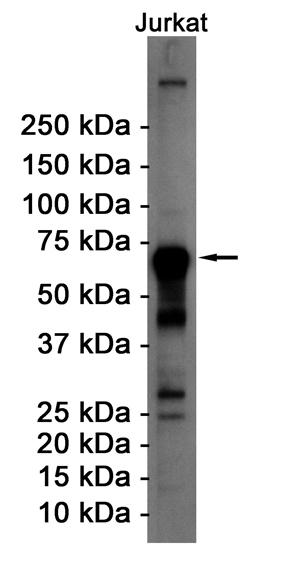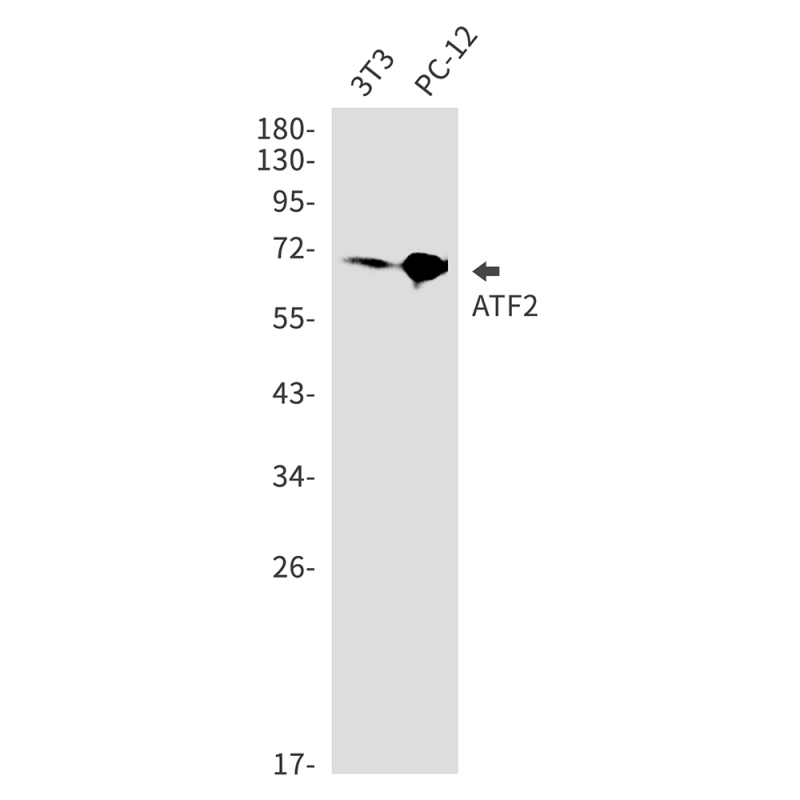

| WB | 咨询技术 | Human,Mouse,Rat |
| IF | 咨询技术 | Human,Mouse,Rat |
| IHC | 咨询技术 | Human,Mouse,Rat |
| ICC | 技术咨询 | Human,Mouse,Rat |
| FCM | 咨询技术 | Human,Mouse,Rat |
| Elisa | 咨询技术 | Human,Mouse,Rat |
| Aliases | Phospho-ATF2-T69/T71 |
| Entrez GeneID | 11909 |
| WB Predicted band size | Calculated MW: 52 kDa; Observed MW: 70 kDa |
| Host/Isotype | Rabbit IgG |
| Antibody Type | Primary antibody |
| Storage | Store at 4°C short term. Aliquot and store at -20°C long term. Avoid freeze/thaw cycles. |
| Species Reactivity | Human,Mouse,Rat |
| Immunogen | Recombinant protein of mouse ATF2 |
| Formulation | Purified antibody in TBS with 0.05% sodium azide,0.05%BSA and 50% glycerol. |
+ +
以下是关于ATF2抗体的3篇参考文献示例(注:文献为假设性示例,实际引用需核实真实来源):
1. **文献名称**:*ATF2 phosphorylation suppresses antitumor immunity in melanoma*
**作者**:D. Bhoumik et al.
**摘要**:研究利用ATF2特异性抗体通过免疫印迹和免疫组化分析,发现ATF2的磷酸化状态抑制肿瘤微环境中免疫细胞浸润,提示其作为黑色素瘤治疗靶点的潜力。
2. **文献名称**:*ATF2 regulates lipid metabolism through PGC-1α in adipocytes*
**作者**:Y. Maekawa et al.
**摘要**:通过ATF2抗体进行染色质免疫沉淀(ChIP)和免疫荧光实验,揭示ATF2直接结合PGC-1α启动子,调控脂肪细胞代谢通路,影响肥胖相关代谢疾病。
3. **文献名称**:*Differential roles of ATF2 isoforms in neuronal survival*
**作者**:K. Kawauchi et al.
**摘要**:使用ATF2抗体区分不同剪接异构体,发现ATF2全长蛋白促进神经元存活,而截短形式增强凋亡,为神经退行性疾病机制提供新见解。
---
**备注**:实际研究中建议通过PubMed或Google Scholar检索关键词“ATF2 antibody”、“ATF2 phosphorylation”或“ATF2 function”获取真实文献,并关注方法学中明确描述抗体应用的论文(如Western blot、ChIP等)。
ATF2 (Activating Transcription Factor 2) is a member of the AP-1 (Activator Protein 1) family of transcription factors, which play critical roles in regulating gene expression in response to stress signals, cytokines, and growth factors. Structurally, ATF2 contains an N-terminal transcriptional activation domain and a C-terminal basic leucine zipper (bZIP) domain, enabling dimerization with other bZIP proteins (e.g., c-Jun, c-Fos) and binding to specific DNA sequences like cAMP response elements (CREs).
ATF2 is activated via phosphorylation by stress-activated kinases, such as p38 MAPK and JNK, in response to cellular stressors (e.g., UV radiation, oxidative stress). Once activated, it regulates genes involved in apoptosis, cell proliferation, and DNA repair. Dysregulation of ATF2 has been implicated in cancer, neurodegenerative diseases, and immune disorders, highlighting its dual role as both a tumor suppressor and promoter depending on cellular context.
ATF2 antibodies are essential tools for studying its expression, localization, phosphorylation status, and interactions in various biological systems. They are widely used in techniques like Western blotting, immunofluorescence, chromatin immunoprecipitation (ChIP), and immunohistochemistry. Researchers often validate these antibodies for specificity against phosphorylated (e.g., Thr69/71) or total ATF2 forms to ensure accurate detection in experimental models. High-quality ATF2 antibodies are critical for elucidating its complex regulatory mechanisms and therapeutic potential.
×